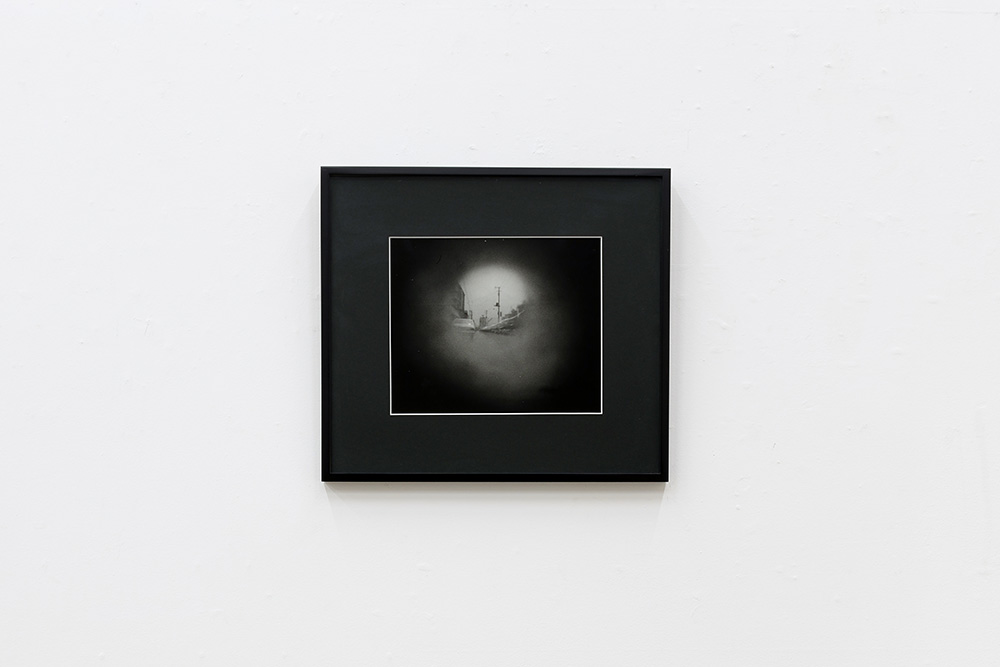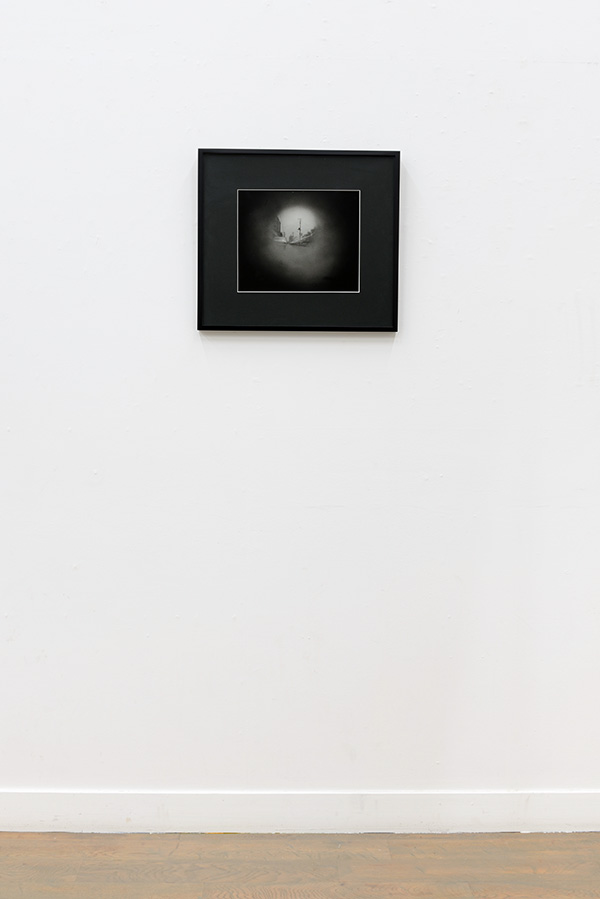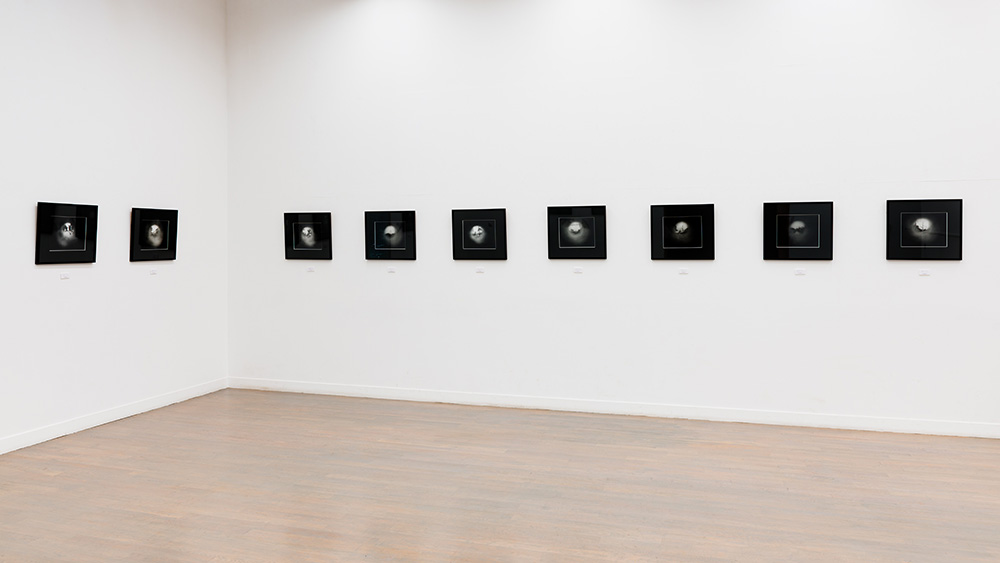
写真再読 山中信夫
2013年9月11日[水]- 10月27日[日]
10:00-18:00(入館は17:30まで)
毎週:月・火曜休館
入館料/通常料金 500円
■ 協力:栃木県立美術館
日本では1960年代より、若手アーティストを中心に写真を現代美術に取り入れた表現が様々な方法で数多く試みられ、山中信夫はピンホールカメラの機構を用いた現代美術としての写真表現で注目を集めました。
本展では13年間ほどの活動期の初期、ピンホールのコンセプトが固まり発表も盛んに行われた1973年に制作された「B&Wピンホール」のシリーズを紹介します。

このピンホールのコンセプトからは3タイプの作品が制作されています。
一つは「ピンホールボックス」で箱の一面に針穴を一つ開けただけの作品。箱の内部には外に広がる世界が反転した画像として収まっているが、誰もその図像を見ることは出来ない。穴から覗こうとすれば光が遮られ、図像そのものが消えて無くなってしまうと言うジレンマに陥る…
もう一つは一般的なピンホールカメラと同様に箱に開けられた針穴(ピンホール)から入る光をフィルムに定着させプリントしたもので、今回の展示作品もこのシリーズに属します。レンズによって効率良く光を集める一般的なカメラと違い、必然的に露光時間をより多く要するピンホールカメラは眼前の風景を瞬間的に捉えると言うよりは、むしろ露光中変化し続けるその「空間」を時間ごと定着させる行為に近い様に感じます。そしてこのフィルム1枚は数秒から数分間の動画を積層し1カットに収めたものと捉える事も可能で、ある「空間」を別の時間・場所に移動すると言う点においては、動画で記録された映像を使用した作品「川を写したフィルムを川に映す」(1971年の処女作)の発想から導き出されたと考える事も出来ます。
そしてもう一つが、部屋(展示空間)そのものをピンホールカメラに見立てた「ピンホール・ルーム」です。針穴を通して入り込む光を壁に貼られた複数のフィルムに収め、感光したフィルムはコンタクトプリントで原寸のまま焼かれ、写真はフィルムを並べた時と同様に再現され展示されるという作品です。
これはいわゆる一般的な写真機では表現出来ない、カメラの外の世界とカメラの中で起こっている現象を同時に記録した作品で、ある作品には室内(カメラ内)にいたであろう作家自身の影が映り込んでいて、被写体と撮影者が同時に光と影の痕跡としてフィルムに記録されています。このことは写真の持つ本来の目的であるカメラの前で起きている事象を正確に写しとると言うことから離れ、表現を目的とした写真になったことを意味しています。
高度成長期、時代の勢いと共に日本では様々な新しいアートが誕生し紹介されましたが、その多くは速い時間の流れの中で時代の一場面として認識されるに留まり、その価値はあまり再検証される機会に恵まれないまま今日に至っている部分があります。しかし昨今、1960年代~70年代に誕生した日本のアートが海外で再評価され、「もの派」や「具体」など海外での展覧会が話題となり、当時を知らない若い世代からも注目を集め、こうした動きは少しずつ日本国内にも広がりを見せています。
当館でも今年1月に「松澤宥展」を開催し、60年代半ばよりコンセプチュアル・アートの世界で先駆的な表現を試みられた松澤氏の仕事を紹介しましたが、本展では山中氏の作品を通し「現代美術としての写真」の一端を紹介すると共にこの展覧会が当時様々な形で発表された、写真による現代美術を再検証するきっかけになればと考えます。

NOBUO YAMANAKA ”Re-reading Photography”
September 11 (Wed) – October 27 (Sun) 2013
10:00 – 18:00 (Last admission 17:30)
Closed on Mondays and Tuesdays
Admission : 500 yen
In cooperation with Tochigi Prefectural Museum of Fine Arts
From 60s, Japanese artists have made various attempts to incorporate photographic expression into modern art. Among these, Yamanaka’s works employing the pinhole mechanism were much noted.
In the present exhibition, we introduce a series titled “B&W pinhole” (1973), from early years of his career where he was particularly active.
The pinhole concept consists of three types of works: pinhole box, photographic works, and pinhole room.
“Pinhole box” is a box with a pinhole on one side, encapsulating a reverse image of the external world that no one can ever see – demonstrating that an act of looking into the pinhole makes the image disappear.
Photographic works, which are presently exhibited, were produced by fixing light entering through a pinhole on a box onto a film, as with a general pinhole camera. A pinhole camera requires longer exposure than a normal camera that condenses light efficiently through a lens, and records an ever-changing scene along with a course of time, rather than momentarily capturing a landscape.
The film stores layers of moving images. This can be connected to the concept of his first work in 1971 projecting a moving image of a river onto the river.
The last one, “pinhole room”, is an exhibition room itself set out as a pinhole camera. Films on walls are exposed to light entering through a pinhole, and images are printed in full scale by contact printing. The photographs thus printed are presented in the same order as the films.
These are works meant for reproducing phenomena inside and outside of the camera. One of those includes a shadow of the artist staying inside the room (camera), being a subject and a photographer at the same time. This shows that these photographs are artistic expressions, not just recording media.
During the period of rapid economic growth, various new arts were introduced in Japan but many of those were perceived as mere aspects of the era and their values have never been reviewed. However, these Japanese arts in 60s and 70s are being reevaluated internationally, as exhibitions of Mono-ha as well as Gutai have become popular also among young people. Such tendency is being reimported to Japan.
Following the exhibition held at our museum in January 2013 introducing Yu Matsuzawa’s radical approaches to conceptual art in mid 60s, the present exhibition introduces photography as modern art, through Yamanaka’s works.
Translation by Miho Ida